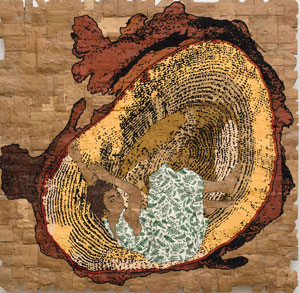7.11.25 — Trees to Newcastle
Bringing trees to Wave Hill is like carrying coals to Newcastle. On second thought, call it the antidote to a darker city—an antidote that it delivers harried New Yorkers every day.
While a bit remote, the public garden and cultural center has a free shuttle van late each week from the last stop on the subway in the Bronx. Besides, the distance from midtown is part of the cure. I look forward each year to the half hour walk from Van Cortlandt Park, past Tudor houses that I could not possibly afford. I make a point of it, along with a report on summer art inside and out,  and this year’s group show in the Glyndor Gallery is all about trees. “Trees, We Breathe” invites you to take a deep breath, inside and out, through September 1. If the trees are short of breath, too, such is climate change.
and this year’s group show in the Glyndor Gallery is all about trees. “Trees, We Breathe” invites you to take a deep breath, inside and out, through September 1. If the trees are short of breath, too, such is climate change.
Wave Hill offers no end of green framing its plush lawn, its greenhouses, and the view to the Palisades across the Hudson. The city as a whole has its share of trees to revive the spirits and to nourish the eye as well—seven million of them, not that far short of its more than eight citizens. Sari Carel calls her painted map City of Trees—with colored dots for trees and wide-open blocks for space to breath. If it is a little spooky, like the view from a drone or a UFO, she keeps things positive, like the show as a whole. Leave politics to others with less art and fewer trees. Its best-known contributor, Yoko Ono, welcomes visitors to write down their personal hopes before tying them to actual trees outdoors.
Remember last summer’s “Perfect Trouble“? This summer’s show revels in imperfections, like most families. Sonja John photographs her next of kin perched high in the trees, in a room of floral patterns like stained glass. Not that she is part of the main show, but she lets in plenty of light. So does Amanda Phingbodhipakkiya, also through July 13, who hangs her colors from the ceiling like a spiritual being or a spirit home. But they could be, like John in the sun room, for greater unity and intimacy than ever.
Same for Sara Jimenez outdoors, with black ceramic urns in the shape of women’s heads, as with Folding Field. The accompanying red curtain descends from trees, through September 21, torn but taking in the breeze. Same, too, for SuRan Song and William M. Weis III through September 1, with You’re Soaking in It. It sounds like more than their canopy bed can deliver, and it is. An actual if unlikely part of the show, Rose B. Simpson stands masked guards by the gallery entrance in steel, but then someone must stand watch over people and the earth. (Monica Duncan and Jennifer Tobas had not yet set out their work, replacing Phingbodhipakkiya and John, when I came.)
Trees take on the materials of everyday life, and they never let go, not even in the face of global warming and climate change. Andrea Bowers starts with an assemblage of mugs, pots, and pints that I can only trust has something to do with growth. And then she nestles in a tree trunk in the face of deforestation and her own Eco Grief. In the end, though, the most effective memories are the most direct. Rachel Sussman gives trees their due in something akin to portrait photos, including balboa, the tree of life. Weihui Lu in ink extends branches gathered from Wave Hill itself with all the elusive elegance of Chinese calligraphy.
These artists carry trees from nature and return them to nature, with echoes of the gallery. Trees come in gold and ink for Sarah Ahmad. They lie flat in bark and latex for Carlie Trosclair and Sam Van Aken. They come cast in white as chestnuts for Michelle Frick. Their branches become surgical tools for Ben Gould. Woe to those who do not undergo the operation.
Here hope lies in trees, but the burden falls on you. Julia Oldham on video imagines their “escape from destruction” in the electric colors of fantasy fiction, while Yeseul Song and Jesse Simpson hear a Whisper of Sunken Forest waiting to rise. Yet healing lies in you as well. The comma in “Trees, We Breathe” changes everything. People breathe air replenished by trees, and people dare to claim it as their due.
Read more, now in a feature-length article on this site.